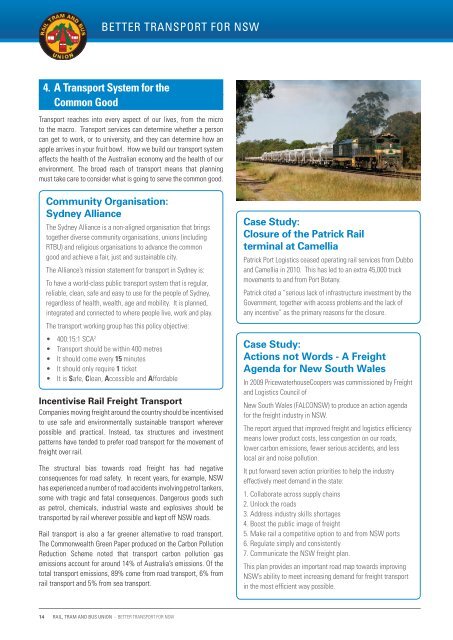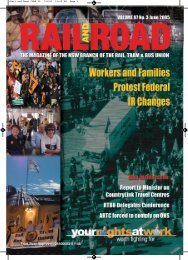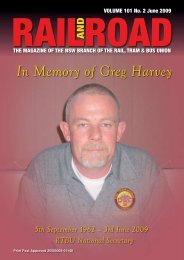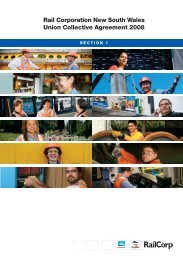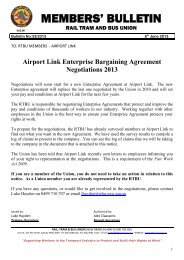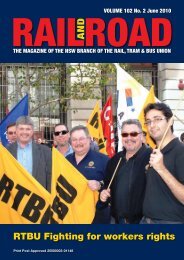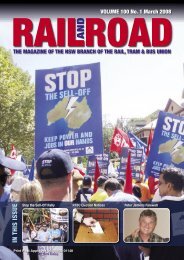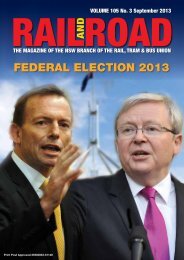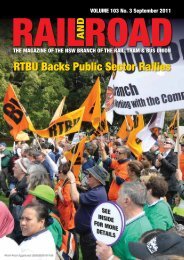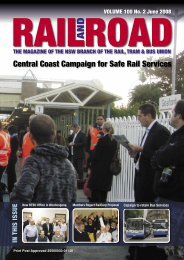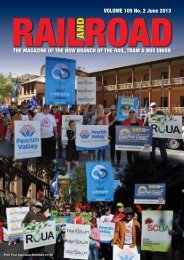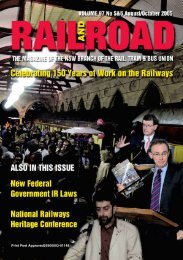Better Transport for NSW - Rail, Tram and Bus Union of NSW
Better Transport for NSW - Rail, Tram and Bus Union of NSW
Better Transport for NSW - Rail, Tram and Bus Union of NSW
You also want an ePaper? Increase the reach of your titles
YUMPU automatically turns print PDFs into web optimized ePapers that Google loves.
BETTER TRANSPORT FOR <strong>NSW</strong><br />
4. A <strong>Transport</strong> System <strong>for</strong> the<br />
Common Good<br />
<strong>Transport</strong> reaches into every aspect <strong>of</strong> our lives, from the micro<br />
to the macro. <strong>Transport</strong> services can determine whether a person<br />
can get to work, or to university, <strong>and</strong> they can determine how an<br />
apple arrives in your fruit bowl. How we build our transport system<br />
affects the health <strong>of</strong> the Australian economy <strong>and</strong> the health <strong>of</strong> our<br />
environment. The broad reach <strong>of</strong> transport means that planning<br />
must take care to consider what is going to serve the common good.<br />
Community Organisation:<br />
Sydney Alliance<br />
The Sydney Alliance is a non-aligned organisation that brings<br />
together diverse community organisations, unions (including<br />
RTBU) <strong>and</strong> religious organisations to advance the common<br />
good <strong>and</strong> achieve a fair, just <strong>and</strong> sustainable city.<br />
The Alliance’s mission statement <strong>for</strong> transport in Sydney is:<br />
To have a world-class public transport system that is regular,<br />
reliable, clean, safe <strong>and</strong> easy to use <strong>for</strong> the people <strong>of</strong> Sydney,<br />
regardless <strong>of</strong> health, wealth, age <strong>and</strong> mobility. It is planned,<br />
integrated <strong>and</strong> connected to where people live, work <strong>and</strong> play.<br />
The transport working group has this policy objective:<br />
• 400:15:1 SCA 2<br />
• <strong>Transport</strong> should be within 400 metres<br />
• It should come every 15 minutes<br />
• It should only require 1 ticket<br />
• It is Safe, Clean, Accessible <strong>and</strong> Af<strong>for</strong>dable<br />
Incentivise <strong>Rail</strong> Freight <strong>Transport</strong><br />
Companies moving freight around the country should be incentivised<br />
to use safe <strong>and</strong> environmentally sustainable transport wherever<br />
possible <strong>and</strong> practical. Instead, tax structures <strong>and</strong> investment<br />
patterns have tended to prefer road transport <strong>for</strong> the movement <strong>of</strong><br />
freight over rail.<br />
The structural bias towards road freight has had negative<br />
consequences <strong>for</strong> road safety. In recent years, <strong>for</strong> example, <strong>NSW</strong><br />
has experienced a number <strong>of</strong> road accidents involving petrol tankers,<br />
some with tragic <strong>and</strong> fatal consequences. Dangerous goods such<br />
as petrol, chemicals, industrial waste <strong>and</strong> explosives should be<br />
transported by rail wherever possible <strong>and</strong> kept <strong>of</strong>f <strong>NSW</strong> roads.<br />
<strong>Rail</strong> transport is also a far greener alternative to road transport.<br />
The Commonwealth Green Paper produced on the Carbon Pollution<br />
Reduction Scheme noted that transport carbon pollution gas<br />
emissions account <strong>for</strong> around 14% <strong>of</strong> Australia’s emissions. Of the<br />
total transport emissions, 89% come from road transport, 6% from<br />
rail transport <strong>and</strong> 5% from sea transport.<br />
Case Study:<br />
Closure <strong>of</strong> the Patrick <strong>Rail</strong><br />
terminal at Camellia<br />
Patrick Port Logistics ceased operating rail services from Dubbo<br />
<strong>and</strong> Camellia in 2010. This has led to an extra 45,000 truck<br />
movements to <strong>and</strong> from Port Botany.<br />
Patrick cited a “serious lack <strong>of</strong> infrastructure investment by the<br />
Government, together with access problems <strong>and</strong> the lack <strong>of</strong><br />
any incentive” as the primary reasons <strong>for</strong> the closure.<br />
Case Study:<br />
Actions not Words - A Freight<br />
Agenda <strong>for</strong> New South Wales<br />
In 2009 PricewaterhouseCoopers was commissioned by Freight<br />
<strong>and</strong> Logistics Council <strong>of</strong><br />
New South Wales (FALCO<strong>NSW</strong>) to produce an action agenda<br />
<strong>for</strong> the freight industry in <strong>NSW</strong>.<br />
The report argued that improved freight <strong>and</strong> logistics efficiency<br />
means lower product costs, less congestion on our roads,<br />
lower carbon emissions, fewer serious accidents, <strong>and</strong> less<br />
local air <strong>and</strong> noise pollution.<br />
It put <strong>for</strong>ward seven action priorities to help the industry<br />
effectively meet dem<strong>and</strong> in the state:<br />
1. Collaborate across supply chains<br />
2. Unlock the roads<br />
3. Address industry skills shortages<br />
4. Boost the public image <strong>of</strong> freight<br />
5. Make rail a competitive option to <strong>and</strong> from <strong>NSW</strong> ports<br />
6. Regulate simply <strong>and</strong> consistently<br />
7. Communicate the <strong>NSW</strong> freight plan.<br />
This plan provides an important road map towards improving<br />
<strong>NSW</strong>’s ability to meet increasing dem<strong>and</strong> <strong>for</strong> freight transport<br />
in the most efficient way possible.<br />
14<br />
RAIL, TRAM AND BUS UNION - BETTER TRANSPORT FOR <strong>NSW</strong>


